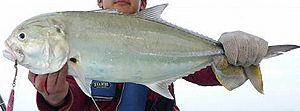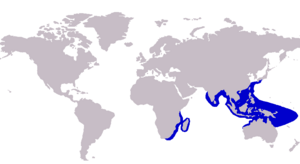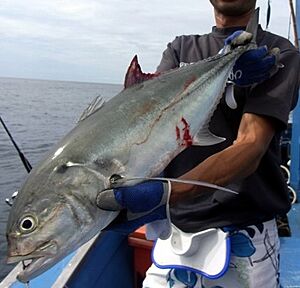Tille trevally facts for kids
Quick facts for kids Tille trevally |
|
|---|---|
 |
|
| Conservation status | |
| Scientific classification | |
 |
|
| Approximate range of the tille trevally | |
| Synonyms | |
|
Caranx cynodon Bleeker, 1851 |
The tille trevally (Caranx tille), also known as the tille kingfish, is a large fish that lives in the ocean. It belongs to the jack family, called Carangidae. You can find the tille trevally in warm, tropical waters. Its home stretches from South Africa all the way to Fiji, Japan, and Australia.
This fish is easy to spot because of its rounded, bumpy head shape. It can grow up to 80 centimeters (about 31 inches) long. It can also weigh as much as 7.2 kg (about 16 pounds). The tille trevally mostly lives near the coast. It likes reefs and lagoons. But sometimes, it is found in deep ocean areas called seamounts. It is a predator, meaning it hunts other fish and crustaceans. People catch the tille trevally for food and for sport. The name "tille" comes from a local name, koton tille, used by fishermen in Pondicherry, India.
Contents
About the Tille Trevally
The tille trevally is part of a group of fish called jacks or trevallies. These fish are all in the Caranx genus. This genus is part of the larger jack and horse mackerel family, Carangidae.
How it Got its Name
A scientist named Georges Cuvier first described this fish in 1833. He named it Caranx tille. The name "tille" came from a local name that fishermen in Pondicherry, India, used for the fish. They called it koton tille.
What the Tille Trevally Looks Like
The tille trevally is a big fish. It can grow up to 80 centimeters long and weigh over 7 kilograms. Its body is flat from side to side, like most jacks. The top of its body is more curved than the bottom. This curve makes its head look a bit blunt or steep. This is a key way to tell it apart from other fish.
Fins and Scales
It has two dorsal fins on its back. The first one has eight stiff spines. The second has one spine and 20 to 22 soft rays. Its anal fin on the bottom has two separate spines. Then it has one more spine and 16 to 18 soft rays. The lateral line on its side is curved at the front. This line has 53 to 54 scales. The straight part of the line has 33 to 42 strong scutes. Scutes are like bony plates. Its chest area is fully covered in scales.
Color and Markings
Young tille trevallies are usually a pale olive or silvery-grey color. Their fins are light or a bit dark. As they get older, their head and upper body turn a darker olive green or bluish-grey. Their belly becomes silvery-white. The second dorsal fin is olive to black. The caudal (tail) and anal fins are yellow-olive to black. This fish also has a black spot on the top edge of its gill cover.
Where the Tille Trevally Lives

The tille trevally lives in the warm, tropical waters of the Indian Ocean and the western Pacific Ocean. You can find it near South Africa and Madagascar. Its range goes north along the east African coast to Tanzania. Then it continues from India to Southeast Asia and Indonesia. It also lives south in northern Australia, north to Japan, and east to Fiji.
Its Home Environment
This fish usually stays close to shore. It loves coral and rocky reefs. It also swims in sandy bays and lagoons. In the Solomon Islands, these fish move with the tides. They go into lagoons when the tide comes in. They leave when the tide goes out. They do this to follow smaller prey fish that go into the lagoons to lay eggs. The tille trevally can also be found in estuaries and the lower parts of rivers. Sometimes, they are found far offshore on deep seamounts. Here, they are one of the top predators.
Life and Fishing
Scientists do not know much about the tille trevally's life. We know it is a predator. It eats other fish and different kinds of crustaceans. It moves into shallow lagoons to hunt small fish that hide and lay eggs in mangroves during high tide. But we do not know how it reproduces or how fast it grows.
Fishing for Tille Trevally
The tille trevally is not a major fish for most fisheries. But it is important in some local areas. For example, in Wewak, Papua New Guinea, it makes up a big part of the fish caught. People catch it using hooks and lines, gill nets, and purse seines. The tille trevally is said to be a very good fish to eat. It is also considered a good game fish for sport fishing, especially the larger ones.
Images for kids
See also
 In Spanish: Caranx tille para niños
In Spanish: Caranx tille para niños



